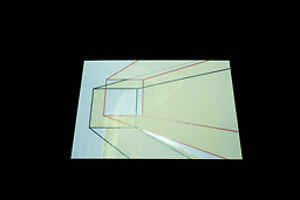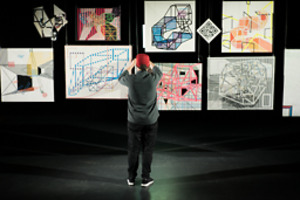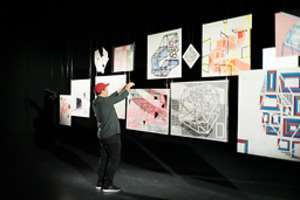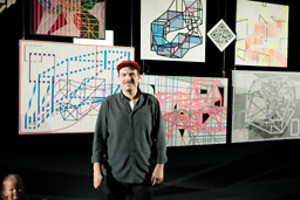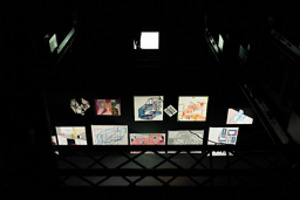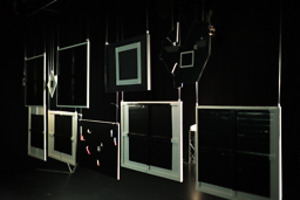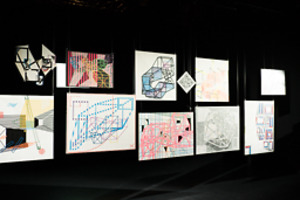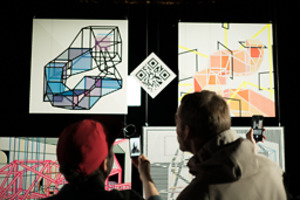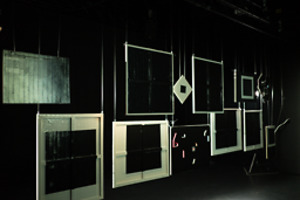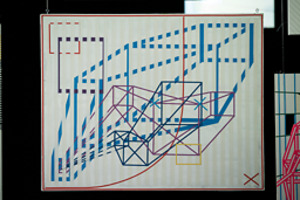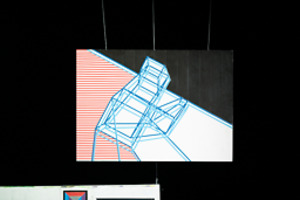"Staatliche Hochschule für Gestaltung (HfG) Karlsruhe"
| Begriff | Staatliche Hochschule für Gestaltung (HfG) Karlsruhe |
| Metakey | Ort: Institution (creative_work:location_institution) |
| Typ | Keyword |
| Vokabular | Werk |
636 Inhalte
- Seite 1 von 53
G.O.T.T.A.L.I.S.T.E.N. (Diplomarbeit)
- Titel
- G.O.T.T.A.L.I.S.T.E.N. (Diplomarbeit)
- Titel (en)
- Grab One Terrene Thought And Let It Slide To Eternal Nothingness (G.O.T.T.A.L.I.S.T.E.N.)
- Beschreibung (de)
- Ort der Kontemplation mit den Eckpfeilern:
Altar, Ikonenreihe (Vorder- und Rückseite), Reliquienschrein und Weißes Rauschen im Raum.
Eine russisch-orthodoxe Klosterkapelle wird mit Mitteln des Ungegenständlichen zum Ort der Zerstreuung.
Es wird nichts gepredigt und nichts direkt angebetet. Lediglich das Setting der Kirche wird in seinen
elementarsten Bestandteilen übernommen und so bestenfalls abstrahiert.
- Ort der Kontemplation mit den Eckpfeilern:
- Typ des Projekts/Werks
- Datierung
- 1.11. 2017 - 3.11. 2017
- Dank an
- Technik/Verfahren/Formate
- -
- Abmessungen
- -
- Dauer
- -
- Ort: Institution
- Ort
- Großes Studio der HfG
- Stadt
- Land
- Titel
- G.O.T.T.A.L.I.S.T.E.N. (Diplomarbeit)
- Urheberrechtshinweis
- C. Claus
- Medienersteller/in
- Importiert am
- 14.02.2019
- Übergeordnete Sets
- 1
G.O.T.T.A.L.I.S.T.E.N. (Diplomarbeit)
- Titel
- G.O.T.T.A.L.I.S.T.E.N. (Diplomarbeit)
- Titel (en)
- Grab One Terrene Thought And Let It Slide To Eternal Nothingness (G.O.T.T.A.L.I.S.T.E.N.)
- Beschreibung (de)
- Ort der Kontemplation mit den Eckpfeilern:
Altar, Ikonenreihe (Vorder- und Rückseite), Reliquienschrein und Weißes Rauschen im Raum.
Eine russisch-orthodoxe Klosterkapelle wird mit Mitteln des Ungegenständlichen zum Ort der Zerstreuung.
Es wird nichts gepredigt und nichts direkt angebetet. Lediglich das Setting der Kirche wird in seinen
elementarsten Bestandteilen übernommen und so bestenfalls abstrahiert.
- Ort der Kontemplation mit den Eckpfeilern:
- Typ des Projekts/Werks
- Datierung
- 1.11. 2017
- Dank an
- Technik/Verfahren/Formate
- -
- Abmessungen
- -
- Dauer
- -
- Ort: Institution
- Ort
- Großes Studio der HfG
- Stadt
- Land
- Titel
- G.O.T.T.A.L.I.S.T.E.N. (Diplomarbeit)
- Urheberrechtshinweis
- C. Claus
- Medienersteller/in
- Importiert am
- 14.02.2019
- Übergeordnete Sets
- 1
G.O.T.T.A.L.I.S.T.E.N. (Diplomarbeit)
- Titel
- G.O.T.T.A.L.I.S.T.E.N. (Diplomarbeit)
- Titel (en)
- Grab One Terrene Thought And Let It Slide To Eternal Nothingness (G.O.T.T.A.L.I.S.T.E.N.)
- Beschreibung (de)
- Ort der Kontemplation mit den Eckpfeilern:
Altar, Ikonenreihe (Vorder- und Rückseite), Reliquienschrein und Weißes Rauschen im Raum.
Eine russisch-orthodoxe Klosterkapelle wird mit Mitteln des Ungegenständlichen zum Ort der Zerstreuung.
Es wird nichts gepredigt und nichts direkt angebetet. Lediglich das Setting der Kirche wird in seinen
elementarsten Bestandteilen übernommen und so bestenfalls abstrahiert.
- Ort der Kontemplation mit den Eckpfeilern:
- Typ des Projekts/Werks
- Datierung
- 1.11. 2017 - 3.11. 2017
- Dank an
- Technik/Verfahren/Formate
- -
- Abmessungen
- -
- Dauer
- -
- Ort: Institution
- Ort
- Großes Studio der HfG
- Stadt
- Land
- Titel
- G.O.T.T.A.L.I.S.T.E.N. (Diplomarbeit)
- Urheberrechtshinweis
- C. Claus
- Medienersteller/in
- Importiert am
- 14.02.2019
- Übergeordnete Sets
- 1
G.O.T.T.A.L.I.S.T.E.N. (Diplomarbeit)
- Titel
- G.O.T.T.A.L.I.S.T.E.N. (Diplomarbeit)
- Titel (en)
- Grab One Terrene Thought And Let It Slide To Eternal Nothingness (G.O.T.T.A.L.I.S.T.E.N.)
- Beschreibung (de)
- Ort der Kontemplation mit den Eckpfeilern:
Altar, Ikonenreihe (Vorder- und Rückseite), Reliquienschrein und Weißes Rauschen im Raum.
Eine russisch-orthodoxe Klosterkapelle wird mit Mitteln des Ungegenständlichen zum Ort der Zerstreuung.
Es wird nichts gepredigt und nichts direkt angebetet. Lediglich das Setting der Kirche wird in seinen
elementarsten Bestandteilen übernommen und so bestenfalls abstrahiert.
- Ort der Kontemplation mit den Eckpfeilern:
- Typ des Projekts/Werks
- Datierung
- 1.11. 2017 - 3.11. 2017
- Dank an
- Technik/Verfahren/Formate
- -
- Abmessungen
- -
- Dauer
- -
- Ort: Institution
- Ort
- Großes Studio der HfG
- Stadt
- Land
- Titel
- G.O.T.T.A.L.I.S.T.E.N. (Diplomarbeit)
- Urheberrechtshinweis
- C. Claus
- Medienersteller/in
- Importiert am
- 14.02.2019
- Übergeordnete Sets
- 1
G.O.T.T.A.L.I.S.T.E.N. (Diplomarbeit)
- Titel
- G.O.T.T.A.L.I.S.T.E.N. (Diplomarbeit)
- Titel (en)
- Grab One Terrene Thought And Let It Slide To Eternal Nothingness (G.O.T.T.A.L.I.S.T.E.N.)
- Beschreibung (de)
- Ort der Kontemplation mit den Eckpfeilern:
Altar, Ikonenreihe (Vorder- und Rückseite), Reliquienschrein und Weißes Rauschen im Raum.
Eine russisch-orthodoxe Klosterkapelle wird mit Mitteln des Ungegenständlichen zum Ort der Zerstreuung.
Es wird nichts gepredigt und nichts direkt angebetet. Lediglich das Setting der Kirche wird in seinen
elementarsten Bestandteilen übernommen und so bestenfalls abstrahiert.
- Ort der Kontemplation mit den Eckpfeilern:
- Typ des Projekts/Werks
- Datierung
- 1.11. 2017 - 3.11. 2017
- Dank an
- Technik/Verfahren/Formate
- -
- Abmessungen
- -
- Dauer
- -
- Ort: Institution
- Ort
- Großes Studio der HfG
- Stadt
- Land
- Titel
- G.O.T.T.A.L.I.S.T.E.N. (Diplomarbeit)
- Urheberrechtshinweis
- C. Claus
- Medienersteller/in
- Importiert am
- 14.02.2019
- Übergeordnete Sets
- 1
G.O.T.T.A.L.I.S.T.E.N. (Diplomarbeit)
- Titel
- G.O.T.T.A.L.I.S.T.E.N. (Diplomarbeit)
- Titel (en)
- Grab One Terrene Thought And Let It Slide To Eternal Nothingness (G.O.T.T.A.L.I.S.T.E.N.)
- Beschreibung (de)
- Ort der Kontemplation mit den Eckpfeilern:
Altar, Ikonenreihe (Vorder- und Rückseite), Reliquienschrein und Weißes Rauschen im Raum.
Eine russisch-orthodoxe Klosterkapelle wird mit Mitteln des Ungegenständlichen zum Ort der Zerstreuung.
Es wird nichts gepredigt und nichts direkt angebetet. Lediglich das Setting der Kirche wird in seinen
elementarsten Bestandteilen übernommen und so bestenfalls abstrahiert.
- Ort der Kontemplation mit den Eckpfeilern:
- Typ des Projekts/Werks
- Datierung
- 1.11. 2017 - 3.11. 2017
- Dank an
- Technik/Verfahren/Formate
- -
- Abmessungen
- -
- Dauer
- -
- Ort: Institution
- Ort
- Großes Studio der HfG
- Stadt
- Land
- Titel
- G.O.T.T.A.L.I.S.T.E.N. (Diplomarbeit)
- Urheberrechtshinweis
- C. Claus
- Medienersteller/in
- Importiert am
- 14.02.2019
- Übergeordnete Sets
- 1
G.O.T.T.A.L.I.S.T.E.N. (Diplomarbeit)
- Titel
- G.O.T.T.A.L.I.S.T.E.N. (Diplomarbeit)
- Titel (en)
- Grab One Terrene Thought And Let It Slide To Eternal Nothingness (G.O.T.T.A.L.I.S.T.E.N.)
- Beschreibung (de)
- Ort der Kontemplation mit den Eckpfeilern:
Altar, Ikonenreihe (Vorder- und Rückseite), Reliquienschrein und Weißes Rauschen im Raum.
Eine russisch-orthodoxe Klosterkapelle wird mit Mitteln des Ungegenständlichen zum Ort der Zerstreuung.
Es wird nichts gepredigt und nichts direkt angebetet. Lediglich das Setting der Kirche wird in seinen
elementarsten Bestandteilen übernommen und so bestenfalls abstrahiert.
- Ort der Kontemplation mit den Eckpfeilern:
- Typ des Projekts/Werks
- Datierung
- 1.11. 2017 - 3.11. 2017
- Dank an
- Technik/Verfahren/Formate
- -
- Abmessungen
- -
- Dauer
- -
- Ort: Institution
- Ort
- Großes Studio der HfG
- Stadt
- Land
- Titel
- G.O.T.T.A.L.I.S.T.E.N. (Diplomarbeit)
- Urheberrechtshinweis
- C. Claus
- Medienersteller/in
- Importiert am
- 14.02.2019
- Übergeordnete Sets
- 1
G.O.T.T.A.L.I.S.T.E.N. (Diplomarbeit)
- Titel
- G.O.T.T.A.L.I.S.T.E.N. (Diplomarbeit)
- Titel (en)
- Grab One Terrene Thought And Let It Slide To Eternal Nothingness (G.O.T.T.A.L.I.S.T.E.N.)
- Beschreibung (de)
- Ort der Kontemplation mit den Eckpfeilern:
Altar, Ikonenreihe (Vorder- und Rückseite), Reliquienschrein und Weißes Rauschen im Raum.
Eine russisch-orthodoxe Klosterkapelle wird mit Mitteln des Ungegenständlichen zum Ort der Zerstreuung.
Es wird nichts gepredigt und nichts direkt angebetet. Lediglich das Setting der Kirche wird in seinen
elementarsten Bestandteilen übernommen und so bestenfalls abstrahiert.
- Ort der Kontemplation mit den Eckpfeilern:
- Typ des Projekts/Werks
- Datierung
- 1.11. 2017 - 3.11. 2017
- Dank an
- Technik/Verfahren/Formate
- -
- Abmessungen
- -
- Dauer
- -
- Ort: Institution
- Ort
- Großes Studio der HfG
- Stadt
- Land
- Titel
- G.O.T.T.A.L.I.S.T.E.N. (Diplomarbeit)
- Urheberrechtshinweis
- C. Claus
- Medienersteller/in
- Importiert am
- 14.02.2019
- Übergeordnete Sets
- 1
G.O.T.T.A.L.I.S.T.E.N. (Diplomarbeit)
- Titel
- G.O.T.T.A.L.I.S.T.E.N. (Diplomarbeit)
- Titel (en)
- Grab One Terrene Thought And Let It Slide To Eternal Nothingness (G.O.T.T.A.L.I.S.T.E.N.)
- Beschreibung (de)
- Ort der Kontemplation mit den Eckpfeilern:
Altar, Ikonenreihe (Vorder- und Rückseite), Reliquienschrein und Weißes Rauschen im Raum.
Eine russisch-orthodoxe Klosterkapelle wird mit Mitteln des Ungegenständlichen zum Ort der Zerstreuung.
Es wird nichts gepredigt und nichts direkt angebetet. Lediglich das Setting der Kirche wird in seinen
elementarsten Bestandteilen übernommen und so bestenfalls abstrahiert.
- Ort der Kontemplation mit den Eckpfeilern:
- Typ des Projekts/Werks
- Datierung
- 1.11. 2017 - 3.11. 2017
- Dank an
- Technik/Verfahren/Formate
- -
- Abmessungen
- -
- Dauer
- -
- Ort: Institution
- Ort
- Großes Studio der HfG
- Stadt
- Land
- Titel
- G.O.T.T.A.L.I.S.T.E.N. (Diplomarbeit)
- Urheberrechtshinweis
- C. Claus
- Medienersteller/in
- Importiert am
- 14.02.2019
- Übergeordnete Sets
- 1
G.O.T.T.A.L.I.S.T.E.N. (Diplomarbeit)
- Titel
- G.O.T.T.A.L.I.S.T.E.N. (Diplomarbeit)
- Titel (en)
- Grab One Terrene Thought And Let It Slide To Eternal Nothingness (G.O.T.T.A.L.I.S.T.E.N.)
- Beschreibung (de)
- Ort der Kontemplation mit den Eckpfeilern:
Altar, Ikonenreihe (Vorder- und Rückseite), Reliquienschrein und Weißes Rauschen im Raum.
Eine russisch-orthodoxe Klosterkapelle wird mit Mitteln des Ungegenständlichen zum Ort der Zerstreuung.
Es wird nichts gepredigt und nichts direkt angebetet. Lediglich das Setting der Kirche wird in seinen
elementarsten Bestandteilen übernommen und so bestenfalls abstrahiert.
- Ort der Kontemplation mit den Eckpfeilern:
- Typ des Projekts/Werks
- Datierung
- 1.11. 2017 - 3.11. 2017
- Dank an
- Technik/Verfahren/Formate
- -
- Abmessungen
- -
- Dauer
- -
- Ort: Institution
- Ort
- Großes Studio der HfG
- Stadt
- Land
- Titel
- G.O.T.T.A.L.I.S.T.E.N. (Diplomarbeit)
- Urheberrechtshinweis
- C. Claus
- Medienersteller/in
- Importiert am
- 14.02.2019
- Übergeordnete Sets
- 1
G.O.T.T.A.L.I.S.T.E.N. (Diplomarbeit)
- Titel
- G.O.T.T.A.L.I.S.T.E.N. (Diplomarbeit)
- Titel (en)
- Grab One Terrene Thought And Let It Slide To Eternal Nothingness (G.O.T.T.A.L.I.S.T.E.N.)
- Beschreibung (de)
- Ort der Kontemplation mit den Eckpfeilern:
Altar, Ikonenreihe (Vorder- und Rückseite), Reliquienschrein und Weißes Rauschen im Raum.
Eine russisch-orthodoxe Klosterkapelle wird mit Mitteln des Ungegenständlichen zum Ort der Zerstreuung.
Es wird nichts gepredigt und nichts direkt angebetet. Lediglich das Setting der Kirche wird in seinen
elementarsten Bestandteilen übernommen und so bestenfalls abstrahiert.
- Ort der Kontemplation mit den Eckpfeilern:
- Typ des Projekts/Werks
- Datierung
- 1.11. 2017 - 3.11. 2017
- Dank an
- Technik/Verfahren/Formate
- -
- Abmessungen
- -
- Dauer
- -
- Ort: Institution
- Ort
- Großes Studio der HfG
- Stadt
- Land
- Titel
- G.O.T.T.A.L.I.S.T.E.N. (Diplomarbeit)
- Urheberrechtshinweis
- C. Claus
- Medienersteller/in
- Importiert am
- 14.02.2019
- Übergeordnete Sets
- 1
G.O.T.T.A.L.I.S.T.E.N. (Diplomarbeit)
- Titel
- G.O.T.T.A.L.I.S.T.E.N. (Diplomarbeit)
- Titel (en)
- Grab One Terrene Thought And Let It Slide To Eternal Nothingness (G.O.T.T.A.L.I.S.T.E.N.)
- Beschreibung (de)
- Ort der Kontemplation mit den Eckpfeilern:
Altar, Ikonenreihe (Vorder- und Rückseite), Reliquienschrein und Weißes Rauschen im Raum.
Eine russisch-orthodoxe Klosterkapelle wird mit Mitteln des Ungegenständlichen zum Ort der Zerstreuung.
Es wird nichts gepredigt und nichts direkt angebetet. Lediglich das Setting der Kirche wird in seinen
elementarsten Bestandteilen übernommen und so bestenfalls abstrahiert.
- Ort der Kontemplation mit den Eckpfeilern:
- Typ des Projekts/Werks
- Datierung
- 1.11. 2017 - 3.11. 2017
- Dank an
- Technik/Verfahren/Formate
- -
- Abmessungen
- -
- Dauer
- -
- Ort: Institution
- Ort
- Großes Studio der HfG
- Stadt
- Land
- Titel
- G.O.T.T.A.L.I.S.T.E.N. (Diplomarbeit)
- Urheberrechtshinweis
- C. Claus
- Medienersteller/in
- Importiert am
- 14.02.2019
- Übergeordnete Sets
- 1
